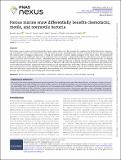Porous marine snow differentially benefits chemotactic, motile, and nonmotile bacteria
Author(s)
Borer, Benedict; Zhang, Irene H; Baker, Amy E; O'Toole, George A; Babbin, Andrew R
Downloadpgac311.pdf (3.474Mb)
Publisher with Creative Commons License
Publisher with Creative Commons License
Creative Commons Attribution
Terms of use
Metadata
Show full item recordAbstract
<jats:title>Abstract</jats:title>
<jats:p>Particulate organic carbon settling through the marine water column is a key process that regulates the global climate by sequestering atmospheric carbon. The initial colonization of marine particles by heterotrophic bacteria represents the first step in recycling this carbon back to inorganic constituents—setting the magnitude of vertical carbon transport to the abyss. Here, we demonstrate experimentally using millifluidic devices that, although bacterial motility is essential for effective colonization of a particle leaking organic nutrients into the water column, chemotaxis specifically benefits at intermediate and higher settling velocities to navigate the particle boundary layer during the brief window of opportunity provided by a passing particle. We develop an individual-based model that simulates the encounter and attachment of bacterial cells with leaking marine particles to systematically evaluate the role of different parameters associated with bacterial run-and-tumble motility. We further use this model to explore the role of particle microstructure on the colonization efficiency of bacteria with different motility traits. We find that the porous microstructure facilitates additional colonization by chemotactic and motile bacteria, and fundamentally alters the way nonmotile cells interact with particles due to streamlines intersecting with the particle surface.</jats:p>
Date issued
2022-12-26Department
Massachusetts Institute of Technology. Department of Earth, Atmospheric, and Planetary SciencesPublisher
Oxford University Press (OUP)
Citation
Borer, Benedict, Zhang, Irene H, Baker, Amy E, O'Toole, George A and Babbin, Andrew R. 2022. "Porous marine snow differentially benefits chemotactic, motile, and nonmotile bacteria." 2 (2).
Version: Final published version
ISSN
2752-6542